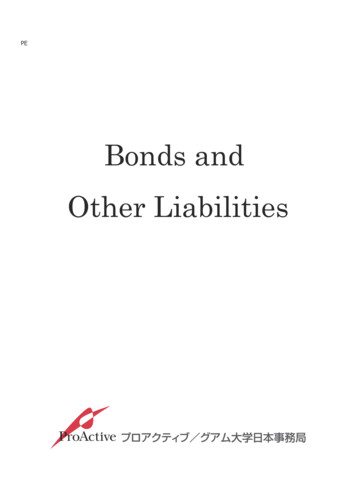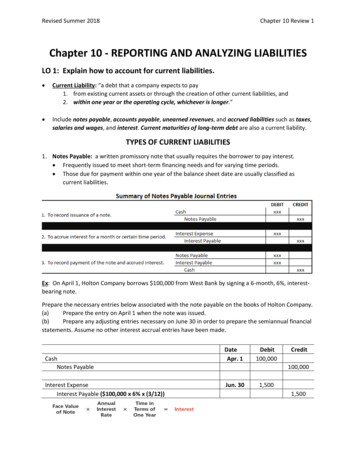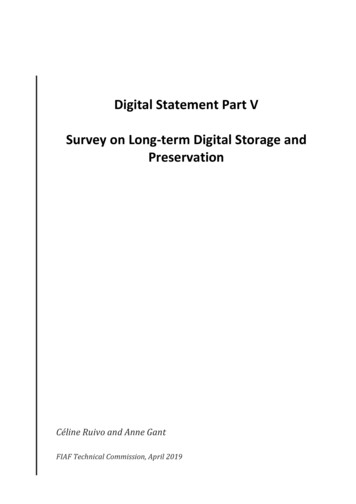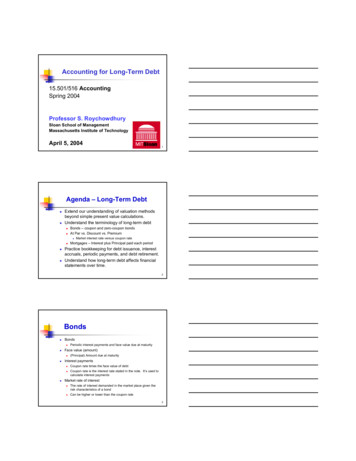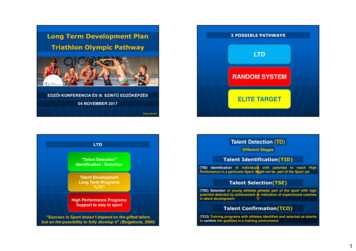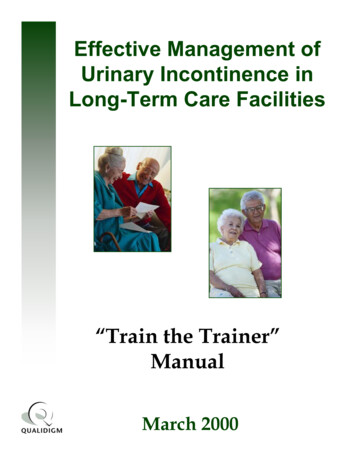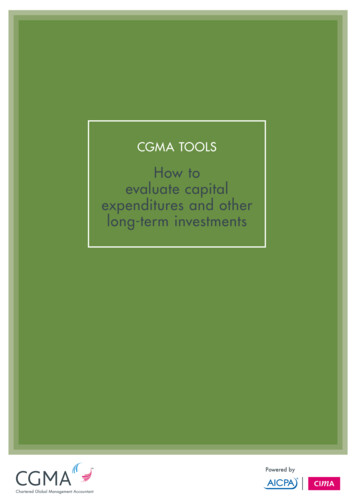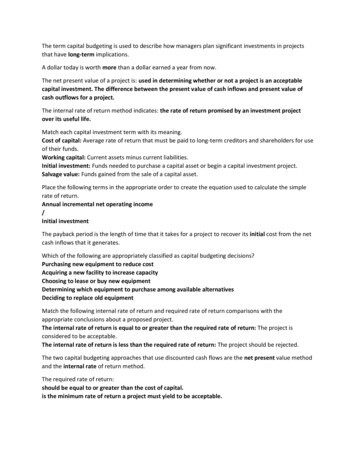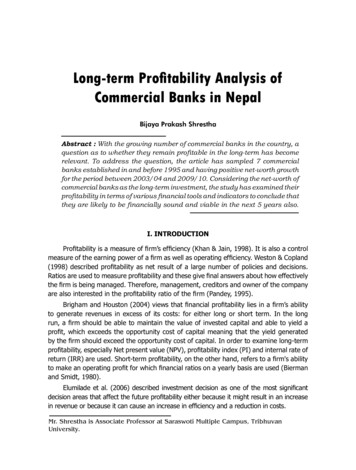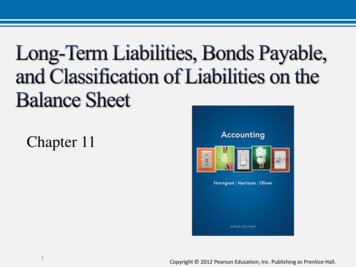
Transcription
Chapter 111Copyright 2012 Pearson Education, Inc. Publishing as Prentice Hall.
Journalize transactions for long-term notespayable and mortgages payableDescribe bonds payableMeasure interest expense on bonds using thestraight-line amortization methodReport liabilities on the balance sheetUse the time value of money: present valueof a bond and effective-interest amortization(see Appendix 11A)Retire bonds payable (see Appendix 11B)2Copyright 2012 Pearson Education, Inc. Publishing as Prentice Hall.
1Journalize transactions for long-term notespayable and mortgages payable3Copyright 2012 Pearson Education, Inc. Publishing as Prentice Hall.
Most long-term notes are paid in installmentsPrincipal due within a year–a current assetPrincipal not due with in a year–long-term assetCurrent plus long-term equals total amount of debtInterest accrues as normal4Copyright 2012 Pearson Education, Inc. Publishing as Prentice Hall.
Yearly payment would include:Installment amountPreviously accrued interest at year-end adjustingAccrued interest since year-end adjustingJournal entry:5Copyright 2012 Pearson Education, Inc. Publishing as Prentice Hall.
Entry included a debit to Long-term notes payableCurrent portion of long-term notes is unchangedNet long-term notes payable equals 15,000Current portion 5,000Long-term portion 10,0006Copyright 2012 Pearson Education, Inc. Publishing as Prentice Hall.
Mortgages PayableDebts backed with a security interest in specificpropertyTitle transfers if the mortgage isn’t paidDiffers from notes payableSecure interest in propertySpecifies monthly paymentReclassify current payments from long-termpayments7Copyright 2012 Pearson Education, Inc. Publishing as Prentice Hall.
Amortization ScheduleDetails each payment’s allocation betweenprincipal and interestAmount to bereclassified to acurrent liability.8Copyright 2012 Pearson Education, Inc. Publishing as Prentice Hall.
Reclassification entryUsually made at year endImmaterial month-to-monthMortgage payment includesInterest expense from amortization tablePrincipal reduction form amortization tablePayment amount agreed upon9Copyright 2012 Pearson Education, Inc. Publishing as Prentice Hall.
On January 1, 2014, LeMay-Finn, Co., signed a 200,000, fiveyear, 6% note. The loan required LeMay-Finn to make paymentson December 31 of 40,000 principal plus interest.1. Journalize the issuance of the note on January1, 2014.DATEJournal EntryACCOUNTSJan 1 CashCREDIT200,000Long-term notes payable10DEBIT200,000Copyright 2012 Pearson Education, Inc. Publishing as Prentice Hall.
(Continued)2. Journalize the reclassification of the currentportion of the note payable.DATEJournal EntryACCOUNTSJan 1 Long-term notes payableCurrent portion of long-termnotes payable11DEBITCREDIT40,00040,000Copyright 2012 Pearson Education, Inc. Publishing as Prentice Hall.
(Continued)3. Journalize the first note payment on December31, 2014.Journal EntryACCOUNTSDATEJan 1 Interest expenseLong-term notes t 2012 Pearson Education, Inc. Publishing as Prentice Hall.
2Describe bonds payable13Copyright 2012 Pearson Education, Inc. Publishing as Prentice Hall.
Long-term liabilityFinancing in large amountsMultiple lenders bondholdersBond certificate evidence of loanAmount borrowed (principal)Maturity dateInterest rateBondholders receive interestNormally two times a yearPrincipal paid at maturity14Copyright 2012 Pearson Education, Inc. Publishing as Prentice Hall.
Principal–amount to be paid backAlso called maturity value, face value or par valueMaturity date–date of principal paybackStated interest rate–also termed face rate,coupon rate, or nominal rateRate of interest paid to bondholdersCash payments during life of bondLike a note, each bond containsPrincipalRateTime15Copyright 2012 Pearson Education, Inc. Publishing as Prentice Hall.
Term bondsAll mature at same dateSerial bondsMature in installments at regular intervalsSecured bondsBacked by assets if company fails to payDebentureUnsecured; not backed by company’s assets16Copyright 2012 Pearson Education, Inc. Publishing as Prentice Hall.
Fluctuates like stockBased upon maturity date and interest rateMaturity (Par) value100% face valueDiscount (Bond discount)Below 100% facePremium (Bond premium)Above 100% facePrice does not affect payment at maturity17Copyright 2012 Pearson Education, Inc. Publishing as Prentice Hall.
Quoted as a percent of maturity valueA 1,000 bond quoted at 101.5 would sell for 1,015 ( 1,000 X 1.015)A 1,000 bond quoted at 89.75 would sell for 897.50 ( 1,000 X .8975)Issue price determines amount receivedPayments equal face amount of principal andinterest18Copyright 2012 Pearson Education, Inc. Publishing as Prentice Hall.
Money earns income over timeTime value of moneyAmount invested today yields more in thefutureInterest accumulates19Copyright 2012 Pearson Education, Inc. Publishing as Prentice Hall.
Stated interest rateRate used to calculateinterest the borrowerpays each yearRemains constantStatedinterestrateMarketinterestrateMarket interest rateRate investors demandfor loaning moneyVaries dailyIssue price of bonds payable9% 9%9% 10%Discount (below maturity value)9% 8%Premium (above maturity value)20Maturity valueCopyright 2012 Pearson Education, Inc. Publishing as Prentice Hall.
Bond prices depend on the market rate of interest, stated rate ofinterest, and time. Determine whether the following bonds payablewill be issued at maturity value, at a premium, or at a discount.a. The market interest rate is 6%. Boise, Corp., issuesbonds payable with a stated rate of 5 3/4%.Discountb. Dallas, Inc., issued 8% bonds payable when themarket rate was 7 1/4%.Premium21Copyright 2012 Pearson Education, Inc. Publishing as Prentice Hall.
(Continued)c. Cleveland Corporation issued 7% bonds when themarket interest rate was 7%.Par valued. Atlanta Company issued bonds payable that pay statedinterest of 7 1/2%. At issuance, the market interest ratewas 9 1/4%.Discount22Copyright 2012 Pearson Education, Inc. Publishing as Prentice Hall.
Bond prices depend on the market rate of interest, stated rate ofinterest, and time.1. Compute the price of the following 7% bondsof United Telecom.a. 500,000 issued at 76.75. 383,750b. 500,000 issued at 104.75. 523,750c. 500,000 issued at 95.75. 478,750d. 500,000 issued at 104.25. 521,25923Copyright 2012 Pearson Education, Inc. Publishing as Prentice Hall.
3Measure interest expense on bonds using thestraight-line amortization method24Copyright 2012 Pearson Education, Inc. Publishing as Prentice Hall.
Maturity value equals 100% bond valueCash received equals principal amount of bondIssuing journal entryInterest payments–semi-annually 100,000 x 9% x 6/12 4,50025Copyright 2012 Pearson Education, Inc. Publishing as Prentice Hall.
Interest payments continue over the bond’s lifeEvery 6 months interest is paidAt maturity date, the principal is paid back26Copyright 2012 Pearson Education, Inc. Publishing as Prentice Hall.
Vernon Corporation issued a 110,000, 6.5%, 15-year bond payable.1. Journalize the following transactions for Vernonand include an explanation for each entrya. Issuance of the bond payable at par on January 1,2012DATEJan 1 CashJournal EntryACCOUNTSBonds payableDEBIT CREDIT110,000110,000Issued bonds payable.27Copyright 2012 Pearson Education, Inc. Publishing as Prentice Hall.
Vernon Corporation issued a 110,000, 6.5%, 15year bond payable1. Journalize the following transactions for Vernonand include an explanation for each entry:b. Payment of semiannual cash interest on July 1,2012Journal EntryACCOUNTSDATEJul 1 Interest expenseCashDEBIT CREDIT3,5753,575Paid semiannual interest.28Copyright 2012 Pearson Education, Inc. Publishing as Prentice Hall.
(Continued)1. Journalize the following transactions for Vernonand include an explanation for each entry:c. Payment of the bond payable at maturity. (Givethe date.)Journal EntryDATEACCOUNTSJan 1 Bonds payable2027CashDEBIT CREDIT110,000110,000Paid off bonds payable at maturity.29Copyright 2012 Pearson Education, Inc. Publishing as Prentice Hall.
Market interest 10%, bond stated rate 9%Cash received is less than the principal amountThe journal entryBond account balances30Copyright 2012 Pearson Education, Inc. Publishing as Prentice Hall.
Balance sheet presentationImmediately after issuanceInterest payments–semi-annually 100,000 X 9% X 6/12 4,500What happens to the 3,851 discount?31Copyright 2012 Pearson Education, Inc. Publishing as Prentice Hall.
The discount is amortizedGradual reduction of over timeDividing into equal amounts for each interest periodThe discount becomes additional interest expenseStraight-line amortizationSimilar to straight-line depreciationBond life yields the interest periods5 year life at 2 times a year 10 periodsDiscount divided by periods amortized amount32Copyright 2012 Pearson Education, Inc. Publishing as Prentice Hall.
Interest payments continue over the bond’s lifeEvery 6 months, interest is paidDiscount is amortized each payment period,reducing the accountAt maturity, the Discount account is zero and thecarrying value is equal to maturity valueAt maturity date, the principal is paid back33Copyright 2012 Pearson Education, Inc. Publishing as Prentice Hall.
Origin, Inc. issued a 40,000, 5%, 10-year bond payable at a price of90 on January 1, 2012.1. Journalize the issuance of the bond payable on January1, 2012.Journal EntryDATEJan 1ACCOUNTSCashDiscount on bonds payableBonds payable34DEBIT CREDIT36,0004,00040,000Copyright 2012 Pearson Education, Inc. Publishing as Prentice Hall.
(Continued)2. Journalize the payment of semiannual interest andamortization of the bond discount or premium on July 1,2012, using the straight-line method to amortize thebond discount or premium.Journal EntryACCOUNTSDATEJan 1 Interest expenseDiscount on bonds payableCash35DEBIT CREDIT1,2002001,000Copyright 2012 Pearson Education, Inc. Publishing as Prentice Hall.
Market interest 8%, bond stated rate 9%Investors pay a premium to acquire themCash received is more than the principal amountIssuing journal entryBond account balances36Copyright 2012 Pearson Education, Inc. Publishing as Prentice Hall.
Balance Sheet presentationImmediately after issuanceInterest payments–semi-annually 100,000 X 9% X 6/12 4,500What happens to the 4,100 premium?37Copyright 2012 Pearson Education, Inc. Publishing as Prentice Hall.
The premium is amortizedGradual reduction of over timeDividing into equal amounts for each interest periodThe premium reduces Interest expenseStraight-line amortizationSimilar to straight-line depreciationBond life yields the interest periods5 year life at 2 times a year 10 periodsPremium divided by periods amortized amount38Copyright 2012 Pearson Education, Inc. Publishing as Prentice Hall.
Interest payments continue over the bond’s lifeEvery 6 months, interest is paidPremium is amortized each payment period,reducing the accountAt maturity, the Premium account is zero and thecarrying value is equal to maturity valueAt maturity date, the principal is paid back39Copyright 2012 Pearson Education, Inc. Publishing as Prentice Hall.
Worthington Mutual Insurance Company issued a 50,000, 5%, 10year bond payable at a price of 108 on January 1, 2012.1. Journalize the issuance of the bond payable on January1, 2012.Journal EntryDATEJan 1ACCOUNTSCashDiscount on bonds payableBonds payable40DEBIT CREDIT54,0004,00050,000Copyright 2012 Pearson Education, Inc. Publishing as Prentice Hall.
(Continued)2. Journalize the payment of semiannual interest andamortization of the bond discount or premium on July1, 2012, using the straight-line method to amortize thebond discount or premium.Journal EntryDATEJul 1ACCOUNTSInterest expensePremium on bonds payableCash41DEBIT CREDIT1,0502001,250Copyright 2012 Pearson Education, Inc. Publishing as Prentice Hall.
Interest payments seldom occur at year-endInterest must be accrued at year-endA payable account is credited for the liabilityEach interest entry must include amortization ofdiscount or premiumOctober, November, and DecemberActual interest payment dateJanuary, February, and March42Copyright 2012 Pearson Education, Inc. Publishing as Prentice Hall.
Interest accrues from stated issue datePayments occur on stated interest payment datesFull payment to bondholders, regardless of their purchasedatePayments cannot be split, full payments are madeInterest accrued prior to issuance is collected at actual issuedateJournal entry43Copyright 2012 Pearson Education, Inc. Publishing as Prentice Hall.
Next interest payment dateInterest payment recorded for normal six monthsInterest expense is equal to three months issuedInterest payable decreased for the cash received at issue dateCash payment is always equal to the six month period44Copyright 2012 Pearson Education, Inc. Publishing as Prentice Hall.
Silk Realty issued 300,000 of 8%, 10-year bonds payable at parvalue on May 1, 2012, four months after the bond’s original issuedate of January 1, 2012.1. Journalize the issuance of the bonds payable onMay 1, 2012.Journal EntryDATEMay 1ACCOUNTSCashBonds payableInterest payable45DEBIT CREDIT308,000300,0008,000Copyright 2012 Pearson Education, Inc. Publishing as Prentice Hall.
(Continued)2. Journalize the payment of the first semiannualinterest amount on July 1, 2012.Journal EntryDATEMay 1ACCOUNTSInterest payableInterest expenseCash46DEBIT CREDIT8,0004,00012,000Copyright 2012 Pearson Education, Inc. Publishing as Prentice Hall.
4Report liabilities on the balance sheet47Copyright 2012 Pearson Education, Inc. Publishing as Prentice Hall.
Reports allcurrent andlong-termliabilitiesPayroll liab
payable and mortgages payable Describe bonds payable Measure interest expense on bonds using the straight-line amortization method Report liabilities on the balance sheet Use the time value of money: present value of a bond and effective-interest amortization (see
